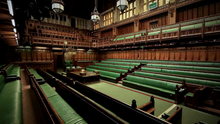Parliamentary snuffbox
The Parliamentary snuffbox ( English "The Parliamentary snuff box") is a wooden box , the free snuff for the deputies of the House contains. The Parliamentary Snuffbox tradition dates back to 1694 when tobacco smoking was banned in the House of Commons. The box is kept in the entrance area of the meeting room at the place of the main door guard. It is the main door guard's responsibility to ensure that snuff is kept in stock.
history
In 1694 the Parliament of England passed a resolution banning smoking in the House of Commons and committee rooms. In order to enable the MPs to consume tobacco nonetheless, snuff was approved as a tolerable alternative to smoking.
The original parliamentary snuffbox was lost when the House of Commons was destroyed by a German aerial bomb in 1941 . The current box was made from scraps of wood from a former door frame that survived the destruction of the chamber. A silver metal plate is attached to the lid on which the names of all the main door guards since 1943 are noted.
The responsibility for the parliamentary snuff box lies with the respective main door guard, who also fills the box with snuff. The tobacco is traditionally paid for from its own salary.
Current use
Since the use of snuff has gone out of fashion over time, the snuffbox of the House of Commons threatened to be forgotten.
A parliamentary question from 2010 confirmed that the snuff box still exists and is full of tobacco throughout. The snuff is selected by the respective main doorkeeper and purchased from a local tobacco dealer. The extent to which the privilege of free snuff is still being used could not be answered, as the last official record dates from 1989. A member of parliament took 1.5 ounces (43 g ) of snuff worth 99 pence from the can.
In 2012, the parliamentary snuffbox was mentioned again in a debate by MP Caroline Lucas and criticized as out of date. The MP Rehman Chishti then put a written question about how high the cost of tobacco had been over the past ten years. The answer showed that there were no costs for Parliament as the tobacco would continue to be purchased by the main door guard. In addition, there are currently no known users of the parliamentary snuffbox. The response also stated that the supply of snuff is allowed in the House of Commons, even though the Health Act 2006 in the United Kingdom prohibits the distribution of tobacco free of charge. Parliament is exempt from this, however, since the Palace of Westminster , in which the Chamber of Commons is located, is officially part of the Royal Palace and is therefore legally outside the scope of the law.
The acting main door guard stated in an interview with the BBC in 2013 that he had no problem with the tradition of the parliamentary snuffbox. He said he was honored to manage the can. In addition, this obligation would not be a major financial burden as his predecessor left him with sufficient supplies of tobacco.
See also
Individual evidence
- ↑ a b Resolution banning smoking in the House of Commons . House of Commons resolution of 1694. Retrieved April 7, 2019.
- ↑ Our Man in Westminster: Perk rarely used by MPs that's not to be sneezed at . Independent on October 23, 2013. Retrieved April 7, 2019.
- ↑ a b c The nose habit: Should MPs snuff it out? . BBC News on 11/5/2013. Retrieved April 7, 2019.
- ↑ request dated July 19, 2010 . WhatDoTheyKnow. Retrieved April 7, 2019.
- ↑ Snuff Said . The Parliamentary Review. 14.09.2018. Retrieved April 7, 2019.
